Balbharti Maharashtra State Board Class 8 History Solutions
Chapter 8 Civil Disobedience Movement Notes, Textbook Exercise Important Questions and Answers.
Class 8 History Chapter 8 Civil Disobedience Movement Textbook Questions and Answers
1. Rewrite the statements by choosing the appropriate options :
(Mahatma Gandhi, Khuda-i-Khidmatgar, [ Ramsay Mac Donald, Sarojini Naidu)
Question 1.
……………. organised the Round Table Conference in London.
Answer:
Ramsay Mac Donald

Question 2.
Khan Abdul Gafar Khan established the organisation named …………….
Answer:
Khuda-i-Khidmatgar
Question 3.
……………. led the Dharasana Satyagraha.
Answer:
Sarojini Naidu
Question 4.
In the Second Round Table Conference ……………. participated as a representative of Indian National Congress.
Answer:
Mahatma Gandhi.
2. Explain the following statements with reasons :
Question 1.
Chandrasing Thakur was court martialled and severely punished.
Answer:
Therefore, he was court-martialled and severely punished.
Question 2.
The Government declared Martial Law at Solapur.
Answer:
Therefore, Martial law was imposed in Solapur by the government.

Question 3.
The deliberation in the First Round Table Conference proved to be meaningless.
Answer:
Thus, the deliberation in the First Round Table Conference proved to be meaningless.
Question 4.
Gandhiji began fast unto death in the Yerwada jail.
Answer:
3. Answer the following questions in 25 to 30 words :
Question 1.
Why did Gandhiji decide to break the Salt Act to begin the Satyagraha?
Answer:
1. Before launching the Civil Disobedience Movement Gandhiji demanded cancellation of salt tax and end the monopoly of the British government to manufacture it.
2. Being an important ingredient in the food of the common people, it was unjust to impose a tax on salt.
3. Gandhiji decided to launch the Salt Satyagraha by a violation of the Salt Act, which was symbolic in breaking all unjust and oppressive laws of the British.

Question 2.
Why did the Indian National Congress withdraw the Civil Disobedience Movement?
Answer:
1. After the failure of the First Round Table Conference, Prime Minister Ramsay Mac Donald hoped that Indian National Congress would participate in the Second Round Table Conference.
2. In order to create a conducive atmosphere Gandhiji and other political leaders were released from jail.
3. A pact was signed after discussion between Gandhiji and Viceroy Irwin.
4. According to the pact, the British Government gave an assurance of providing Responsible Government in the proposed constitution of India.
5. So, the congress agreed to suspend the Civil Disobedience Movement and participate in the Second Round Table Conference.
4. Complete the following timeline of Civil Disobedience Movement:
Question 1.

Answer:


Do you Know?
Features of the Civil Disobedience Movement :
1. All the movements, till now, were limited only to urban areas. But this movement became a nationwide movement. People from rural areas registered their participation. Women also took part in large numbers. Kasturba Gandhi, Kamladevi Chattopadhyay, Ayantikaba I Gokha le, Lilavati Munshi, Hansaben Mehta led the satyagraha.
2. This movement was based on complete nonviolence. The British Government was trying to greatly suppress the movement, but the people protested unarmed. Due to this, the Indian people became fearless.
project:
Question 1.
Gather additional information along with photographs about the work of the following personalities in the Civil Disobedience Movement and exhibit it in the class. (a) Sarojini Naidu (b) Khan Abdul Gafar Khan (c) Babu Genu Said.

Question 2.
The plot on an outline map of India, the places mentioned in the chapter where the Civil Disobedience Movement took place.
Class 8 History Chapter 8 Civil Disobedience Movement Additional Important Questions and Answers
Rewrite the statements by choosing the appropriate options :
Question 1.
After the resolution of Complete Independence was passed in Lahore session, Gandhiji decided to launch ……………. Movement.
(a) Home Rule
(b) Non-co-operation
(c) Quit India
(d) Civil Disobedience
Answer:
(d) Civil Disobedience
Question 2.
During Civil Disobedience Movement, government imposed Martial law in ……………. .
(a) Peshawar
(b) Solapur
(c) Pune
(d) Mumbai
Answer:
(b) Solapur
Question 3.
Gandhiji withdrew the Civil Disobedience Movement in ……………. .
(a) April 1934
(b) March 1930
(c) November 1932
(d) May 1933
Answer:
(a) April 1934

Question 4.
Gandhiji broke the Salt Act at ……………. .
(a) Dandi
(b) Peshawar
(c) Dharasana
(d) Yerwada
Answer:
(a) Dandi
Question 5.
The British government gave orders to regiment in Peshawar to ……………. open fire on the satyagrahis.
(a) Garhwal
(b) Sikh
(c) Maratha
(d) Rajput
Answer:
(a) Garhwal
Name the following :
Question 1.
Follower of Gandhiji known as Frontier Gandhi.
Answer:
Khan Abdul Gafar Khan
Question 2.
Volunteer who died in firing at Solapur satyagraha.
Answer:
Shankar Shivdare
Question 3.
Laid down his life in front of the truck boycotting foreign goods in Mumbai.
Answer:
Babu Genu Said
Question 4.
Attended the Second Round Table Conference as representative of Dalits.
Answer:
Dr. Babasaheb Ambedkar.
Answer the following questions in one sentence :
Question 1.
What was the objective of Gandhiji in starting the Civil Disobedience?
Answer:
The objective of Gandhiji was to break the oppressive and unjust laws of the British Government through peace and Satyagraha.

Question 2.
From which place and when did the Dandi March start?
Answer:
The Dandi March started from Sabarmati Ashram in Ahmedabad on 12 March, 1930.
Question 3.
Name the leaders present at the First Round Table Conference.
Answer:
Dr. Babasaheb Ambedkar, Sir Tej Bahadur Sapru, Barrister Jinnah were the leaders present at the First Round Table Conference.
Question 4.
Which issues were discussed in the First Round Table Conference?
Answer:
The issues like Responsible Government at centre and establishment of Federal State in India were discussed.
Question 5.
What decision was made in the Poona Pact?
Answer:
According to the Poona Pact, separate electorates for the Dalits was cancelled and a provision for reserved seats was made.
Do as Directed :
Complete the graphical presentation :
Question 1.
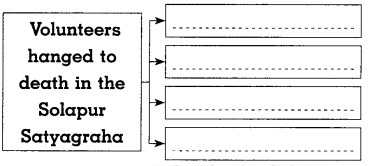
Answer:
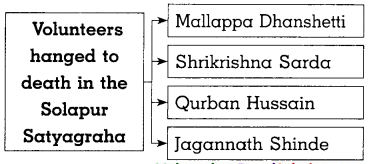

Question 2.
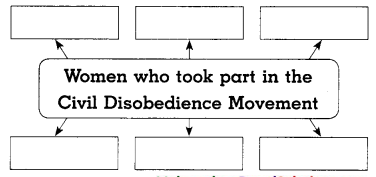
Answer:
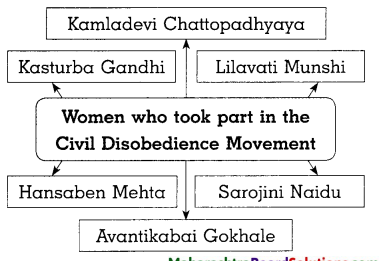
Question 3.
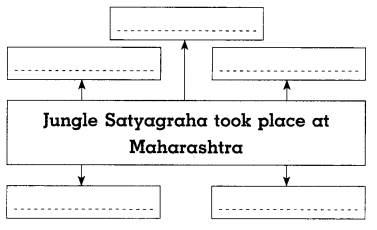
Answer:
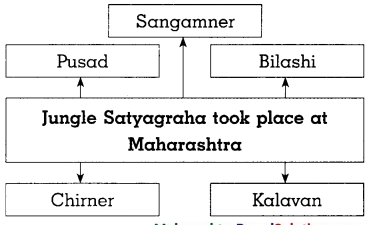
Write short notes :
Question 1.
Gandhi-Irwin Pact :
Answer:
1. On the appeal of the Prime Minister, the Viceroy released Gandhiji and other political leaders from prison.
2. In this conducive atmosphere, a pact was signed between Gandhiji and Viceroy Irwin. It is known as Gandhi-Irwin Pact.

Question 2.
Second Round Table Conference :
Answer:
Question 3.
Poona Pact :
Answer:
Question 4.
The Round Table Conference :
Answer:
Answer the following questions in 25 to 30 words :
Question 1.
Write about the sacrifice of Babu Genu.
Answer:

Question 2.
Write features of Civil Disobedience Movement.
Answer:
The Civil Disobedience Movement launched in 1930 had the following features :
Question 3.
What suppressive measures were adopted by the British government after the Second Round Table Conference?
Answer:
Explain the following statements with reasons :
Question 1.
Gandhiji was arrested on 4th May 1930.
Answer:
The British government found itself in a difficult situation. So, Gandhiji was arrested on 4th May 1930.

Question 2.
Gandhiji returned disappointed from the Second Round Table Conference.
Answer:
Read the passage and answer the questions given below:
Passage:
The satyagraha at …………….
………………… Malavan and Shiroda.
Question 1.
Who led the Dharasana Satyagraha?
Answer:
Sarojini Naidu led the Dharasana Satyagraha in Gujarat.
Question 2.
At which places in Maharashtra did Salt Satyagraha take place?
Answer:
The Salt Satyagraha in Maharashtra took place at Wadala, Malvan and Shiroda.
Question 3.
Give a brief account of the Dharasana Satyagraha.
Answer:
Answer the following in detail:
Question 1.
Explain the extensive nature of Civil Disobedience Movement.
Answer:

Question 2.
Write information of Dandi March.
Answer:
Question 3.
Do you feel Gandhiji’s Civil Disobedience technique can be used in present times?
Answer:
Chapter 8 Civil Disobedience Movement Notes, Textbook Exercise Important Questions and Answers.
Class 8 History Chapter 8 Civil Disobedience Movement Textbook Questions and Answers
1. Rewrite the statements by choosing the appropriate options :
(Mahatma Gandhi, Khuda-i-Khidmatgar, [ Ramsay Mac Donald, Sarojini Naidu)
Question 1.
……………. organised the Round Table Conference in London.
Answer:
Ramsay Mac Donald

Question 2.
Khan Abdul Gafar Khan established the organisation named …………….
Answer:
Khuda-i-Khidmatgar
Question 3.
……………. led the Dharasana Satyagraha.
Answer:
Sarojini Naidu
Question 4.
In the Second Round Table Conference ……………. participated as a representative of Indian National Congress.
Answer:
Mahatma Gandhi.
2. Explain the following statements with reasons :
Question 1.
Chandrasing Thakur was court martialled and severely punished.
Answer:
Therefore, he was court-martialled and severely punished.
Question 2.
The Government declared Martial Law at Solapur.
Answer:
Therefore, Martial law was imposed in Solapur by the government.

Question 3.
The deliberation in the First Round Table Conference proved to be meaningless.
Answer:
Thus, the deliberation in the First Round Table Conference proved to be meaningless.
Question 4.
Gandhiji began fast unto death in the Yerwada jail.
Answer:
3. Answer the following questions in 25 to 30 words :
Question 1.
Why did Gandhiji decide to break the Salt Act to begin the Satyagraha?
Answer:
1. Before launching the Civil Disobedience Movement Gandhiji demanded cancellation of salt tax and end the monopoly of the British government to manufacture it.
2. Being an important ingredient in the food of the common people, it was unjust to impose a tax on salt.
3. Gandhiji decided to launch the Salt Satyagraha by a violation of the Salt Act, which was symbolic in breaking all unjust and oppressive laws of the British.

Question 2.
Why did the Indian National Congress withdraw the Civil Disobedience Movement?
Answer:
1. After the failure of the First Round Table Conference, Prime Minister Ramsay Mac Donald hoped that Indian National Congress would participate in the Second Round Table Conference.
2. In order to create a conducive atmosphere Gandhiji and other political leaders were released from jail.
3. A pact was signed after discussion between Gandhiji and Viceroy Irwin.
4. According to the pact, the British Government gave an assurance of providing Responsible Government in the proposed constitution of India.
5. So, the congress agreed to suspend the Civil Disobedience Movement and participate in the Second Round Table Conference.
4. Complete the following timeline of Civil Disobedience Movement:
Question 1.

Answer:


Do you Know?
Features of the Civil Disobedience Movement :
1. All the movements, till now, were limited only to urban areas. But this movement became a nationwide movement. People from rural areas registered their participation. Women also took part in large numbers. Kasturba Gandhi, Kamladevi Chattopadhyay, Ayantikaba I Gokha le, Lilavati Munshi, Hansaben Mehta led the satyagraha.
2. This movement was based on complete nonviolence. The British Government was trying to greatly suppress the movement, but the people protested unarmed. Due to this, the Indian people became fearless.
project:
Question 1.
Gather additional information along with photographs about the work of the following personalities in the Civil Disobedience Movement and exhibit it in the class. (a) Sarojini Naidu (b) Khan Abdul Gafar Khan (c) Babu Genu Said.

Question 2.
The plot on an outline map of India, the places mentioned in the chapter where the Civil Disobedience Movement took place.
Class 8 History Chapter 8 Civil Disobedience Movement Additional Important Questions and Answers
Rewrite the statements by choosing the appropriate options :
Question 1.
After the resolution of Complete Independence was passed in Lahore session, Gandhiji decided to launch ……………. Movement.
(a) Home Rule
(b) Non-co-operation
(c) Quit India
(d) Civil Disobedience
Answer:
(d) Civil Disobedience
Question 2.
During Civil Disobedience Movement, government imposed Martial law in ……………. .
(a) Peshawar
(b) Solapur
(c) Pune
(d) Mumbai
Answer:
(b) Solapur
Question 3.
Gandhiji withdrew the Civil Disobedience Movement in ……………. .
(a) April 1934
(b) March 1930
(c) November 1932
(d) May 1933
Answer:
(a) April 1934

Question 4.
Gandhiji broke the Salt Act at ……………. .
(a) Dandi
(b) Peshawar
(c) Dharasana
(d) Yerwada
Answer:
(a) Dandi
Question 5.
The British government gave orders to regiment in Peshawar to ……………. open fire on the satyagrahis.
(a) Garhwal
(b) Sikh
(c) Maratha
(d) Rajput
Answer:
(a) Garhwal
Name the following :
Question 1.
Follower of Gandhiji known as Frontier Gandhi.
Answer:
Khan Abdul Gafar Khan
Question 2.
Volunteer who died in firing at Solapur satyagraha.
Answer:
Shankar Shivdare
Question 3.
Laid down his life in front of the truck boycotting foreign goods in Mumbai.
Answer:
Babu Genu Said
Question 4.
Attended the Second Round Table Conference as representative of Dalits.
Answer:
Dr. Babasaheb Ambedkar.
Answer the following questions in one sentence :
Question 1.
What was the objective of Gandhiji in starting the Civil Disobedience?
Answer:
The objective of Gandhiji was to break the oppressive and unjust laws of the British Government through peace and Satyagraha.

Question 2.
From which place and when did the Dandi March start?
Answer:
The Dandi March started from Sabarmati Ashram in Ahmedabad on 12 March, 1930.
Question 3.
Name the leaders present at the First Round Table Conference.
Answer:
Dr. Babasaheb Ambedkar, Sir Tej Bahadur Sapru, Barrister Jinnah were the leaders present at the First Round Table Conference.
Question 4.
Which issues were discussed in the First Round Table Conference?
Answer:
The issues like Responsible Government at centre and establishment of Federal State in India were discussed.
Question 5.
What decision was made in the Poona Pact?
Answer:
According to the Poona Pact, separate electorates for the Dalits was cancelled and a provision for reserved seats was made.
Do as Directed :
Complete the graphical presentation :
Question 1.

Answer:


Question 2.

Answer:

Question 3.

Answer:

Write short notes :
Question 1.
Gandhi-Irwin Pact :
Answer:
1. On the appeal of the Prime Minister, the Viceroy released Gandhiji and other political leaders from prison.
2. In this conducive atmosphere, a pact was signed between Gandhiji and Viceroy Irwin. It is known as Gandhi-Irwin Pact.

Question 2.
Second Round Table Conference :
Answer:
Question 3.
Poona Pact :
Answer:
Question 4.
The Round Table Conference :
Answer:
Answer the following questions in 25 to 30 words :
Question 1.
Write about the sacrifice of Babu Genu.
Answer:

Question 2.
Write features of Civil Disobedience Movement.
Answer:
The Civil Disobedience Movement launched in 1930 had the following features :
Question 3.
What suppressive measures were adopted by the British government after the Second Round Table Conference?
Answer:
Explain the following statements with reasons :
Question 1.
Gandhiji was arrested on 4th May 1930.
Answer:
The British government found itself in a difficult situation. So, Gandhiji was arrested on 4th May 1930.

Question 2.
Gandhiji returned disappointed from the Second Round Table Conference.
Answer:
Read the passage and answer the questions given below:
Passage:
The satyagraha at …………….
………………… Malavan and Shiroda.
Question 1.
Who led the Dharasana Satyagraha?
Answer:
Sarojini Naidu led the Dharasana Satyagraha in Gujarat.
Question 2.
At which places in Maharashtra did Salt Satyagraha take place?
Answer:
The Salt Satyagraha in Maharashtra took place at Wadala, Malvan and Shiroda.
Question 3.
Give a brief account of the Dharasana Satyagraha.
Answer:
Answer the following in detail:
Question 1.
Explain the extensive nature of Civil Disobedience Movement.
Answer:

Question 2.
Write information of Dandi March.
Answer:
Question 3.
Do you feel Gandhiji’s Civil Disobedience technique can be used in present times?
Answer: